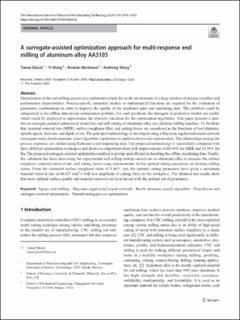| dc.contributor.author | Ghosh, Tamal | |
| dc.contributor.author | Yi, Wang | |
| dc.contributor.author | Martinsen, Kristian | |
| dc.contributor.author | Wang, Kesheng | |
| dc.date.accessioned | 2021-03-02T16:08:03Z | |
| dc.date.available | 2021-03-02T16:08:03Z | |
| dc.date.created | 2020-10-28T13:14:52Z | |
| dc.date.issued | 2020 | |
| dc.identifier.citation | The International Journal of Advanced Manufacturing Technology. 2020, 111 2419-2493. | en_US |
| dc.identifier.issn | 0268-3768 | |
| dc.identifier.uri | https://hdl.handle.net/11250/2731254 | |
| dc.description.abstract | Optimization of the end milling process is a combinatorial task due to the involvement of a large number of process variables and performance characteristics. Process-specific numerical models or mathematical functions are required for the evaluation of parametric combinations in order to improve the quality of the machined parts and machining time. This problem could be categorized as the offline data-driven optimization problem. For such problems, the surrogate or predictive models are useful, which could be employed to approximate the objective functions for the optimization algorithms. This paper presents a data-driven surrogate-assisted optimizer to model the end mill cutting of aluminum alloy on a desktop milling machine. To facilitate that, material removal rate (MRR), surface roughness (Ra), and cutting forces are considered as the functions of tool diameter, spindle speed, feed rate, and depth of cut. The principal methodology is developed using a Bayesian regularized neural network (surrogate) and a beetle antennae search algorithm (optimizer) to perform the process optimization. The relationships among the process responses are studied using Kohonen’s self-organizing map. The proposed methodology is successfully compared with three different optimization techniques and shown to outperform them with improvements of 40.98% for MRR and 10.56% for Ra. The proposed surrogate-assisted optimization method is prompt and efficient in handling the offline machining data. Finally, the validation has been done using the experimental end milling cutting carried out on aluminum alloy to measure the surface roughness, material removal rate, and cutting forces using dynamometer for the optimal cutting parameters on desktop milling center. From the estimated surface roughness value of 0.4651 μm, the optimal cutting parameters have given a maximum material removal rate of 44.027 mm3/s with less amplitude of cutting force on the workpiece. The obtained test results show that more optimal surface quality and material removal can be achieved with the optimal set of parameters. | en_US |
| dc.language.iso | eng | en_US |
| dc.publisher | Springer | en_US |
| dc.rights | Navngivelse 4.0 Internasjonal | * |
| dc.rights.uri | http://creativecommons.org/licenses/by/4.0/deed.no | * |
| dc.title | A Surrogate-Assisted Optimization Approach for Multi-Response End Milling of Aluminium Alloy AA3105 | en_US |
| dc.type | Peer reviewed | en_US |
| dc.type | Journal article | en_US |
| dc.description.version | publishedVersion | en_US |
| dc.source.pagenumber | 2419-2493 | en_US |
| dc.source.volume | 111 | en_US |
| dc.source.journal | The International Journal of Advanced Manufacturing Technology | en_US |
| dc.identifier.doi | 10.1007/s00170-020-06209-6 | |
| dc.identifier.cristin | 1842936 | |
| cristin.ispublished | true | |
| cristin.fulltext | postprint | |
| cristin.qualitycode | 2 | |

